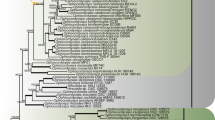Abstract
Ophiocordyceps pulvinata, a pathogen of ants, is formally described as a new species. Genus level designation of this species is difficult due to several apparently conflicting morphological and ecological characters. Affinity with Ophiocordyceps is suggested by the dark color stroma and ascospore morphology. However, the species was included in a book of entomopathogenic fungi of Japan as Torrubiella sp. due to the production of perithecia on an astipitate stroma. Phylogenetic analyses of molecular data support a close relationship with O. unilateralis, a finding consistent with morphological characteristics of the color, asci and ascospores and ecological traits of host affiliation. Thus, O. pulvinata represents another example of the loss of stipe for the hypocrealean arthropod pathogenic fungi and highlights the utility of asci and ascospore morphology as taxonomically informative characters of closely related taxa.


Similar content being viewed by others
References
Castlebury LA, Rossman AY, Sung G-H, Hyten AS, Spatafora JW (2004) Multigene phylogeny reveals new lineage for Stachybotrys chartarum, the indoor air fungus. Mycol Res 108:864–872
de Queiroz A, Gatesy J (2007) The supermatrix approach to systematics. Trends Ecol Evol 22:34–41
Diehl WW (1950) Balansia and the Balansiae in America. Agricultural monograph No. 4. USDA, Washington
Evans HC, Samson RA (1982) Cordyceps species and their anamorphs pathogenic on ants (Formicidae) in tropical forest ecosystems I. The Cephalotes (Myrmicinae) complex. Trans Br Mycol Soc 79:431–453
Hall TA (1999) BioEdit: a user-friendly biological sequence alignment editor and analysis program for Windows 95/98/NT. Nucl Acids Symp Ser 41:95–98
Hodge KT (2003) Clacicipitaceous anamorphs. In: White JF, Bacon CW, Hywel-Jones NL, Spatafora JW (eds) Clavicipitalean fungi: evolutionary biology, chemistry, biocontrol and cultural impacts. Marcel Dekker, Inc., New York, pp 75–123
Johnson D, Sung G, Hywel-Jones NL, Luangsa-Ard JJ, Bischoff JF, Kepler RM, Spatafora JW (2009) Systematics and evolution of the genus Torrubiella (Hypocreales, Ascomycota). Mycol Res 113:279–289
Katoh K, Toh H (2008) Recent developments in the MAFFT multiple sequence alignment program. Brief Bioinform 9:286–298
Katoh K, Misawa K, Kuma K, Miyata T (2002) MAFFT: a novel method for rapid multiple sequence alignment based on fast Fourier transform. Nucl Acids Res 30:3059–3066
Kobayasi Y (1939) On the genus Cordyceps and its allies parasitic to Hymenoptera in Japan. Bull Biogeograph Soc Jpn 9:271–291
Kobayasi Y (1941) The genus Cordyceps and its allies. Sci Rep Tokyo Bunrika Daigaku 84:53–260
Kobayasi Y (1981a) Revision of the genus Cordyceps and its allies 1. Bull Natl Sci Mus Tokyo Ser B 7:1–13
Kobayasi Y (1981b) Revision of the genus Cordyceps and its allies 2. Bull Natl Sci Mus Tokyo Ser B 7:123–129
Kobayasi Y (1982) Keys to the taxa of the genera Cordyceps and Torrubiella. Trans Mycol Soc Jpn 23:329–364
Kobayasi Y, Shimizu D (1982) Monograph of the genus Torrubiella. Bull Natl Sci Mus Tokyo Ser B 8:43–78
Liu Y, Whelen S, Hall B (1999) Phylogenetic relationships among ascomycetes: evidence from an RNA polymerse II subunit. Mol Biol Evol 16:1799–1808
Mains ER (1958) North American entomogenous species of Cordyceps. Mycologia 50:169–222
Massee G (1895) A revision of the genus Cordyceps. Ann Bot Lond 9:1–44
Petch T (1931) Notes on entomogenous fungi. Trans Br Mycol Soc 16:55–75
Rogerson CT (1970) The hypocrealean fungi (Ascomycetes, Hypocreales). Mycologia 62:865–910
Samson RA, Van Reenen-Hoekstra ES, Evans HC (1989) New species of Torrubiella (Ascomycotina: Clavicipitales) on insects from Ghana. Stud Mycol 31:123–132
Shimizu D (1997) Illustrated vegetable wasps and plant worms in colour. Ie-No-Hikari Association, Tokyo, p 187
Stamatakis A (2006) RAxML-VI-HPC: maximum likelihood-based phylogenetic analyses with thousands of taxa and mixed models. Bioinformatics 22:2688–2690
Sung G, Sung J, Hywel-Jones NL, Spatafora JW (2007a) A multi-gene phylogeny of Clavicipitaceae (Ascomycota, Fungi): identification of localized incongruence using a combinational bootstrap approach. Mol Phylogenet Evol 44:1204–1223
Sung G, Hywel-Jones NL, Sung J, Luangsa-ard JJ, Shrestha B, Spatafora JW (2007b) Phylogenetic classification of Cordyceps and the clavicipitaceous fungi. Stud Mycol 57:5–59
Vilgalys R, Sun BL (1994) Ancient and recent patterns of geographic speciation in the oyster mushroom Pleurotus revealed by phylogenetic analysis of ribosomal DNA sequences. Proc Natl Acad Sci 91:4599–4603
White TJ, Bruns TD, Lee S, Taylor J (1990) Amplification and direct sequencing of fungal ribosomal RNA genes for phylogenetics. In: Innis MA, Gelfand DH, Sninsky JJ, White TJ (eds) PCR protocols: a guide to methods and applications. Academic Press, San Diego, pp 315–322
Acknowledgments
We would like to thank Dr. James Trappe for providing the Latin diagnosis. Also, our sincere thanks go out to all the members of the Japan Society for Vegetable Wasps and Plant Worms (Tohchukaso No Kai) for thoughtful discussion and insight into the local fungi, and especially Prof. Noriko Kinjo for assistance with naming, and Dr. Yasumasa Okuzawa and Mr. and Mrs. Kajiyama for providing specimens from their personal collections for use in this study. This research was funded by a National Science Foundation (USA) PEET grant to J.W. Spatafora (DEB-0529752).
Author information
Authors and Affiliations
Corresponding author
About this article
Cite this article
Kepler, R.M., Kaitsu, Y., Tanaka, E. et al. Ophiocordyceps pulvinata sp. nov., a pathogen of ants with a reduced stroma. Mycoscience 52, 39–47 (2011). https://doi.org/10.1007/s10267-010-0072-5
Received:
Accepted:
Published:
Issue Date:
DOI: https://doi.org/10.1007/s10267-010-0072-5




